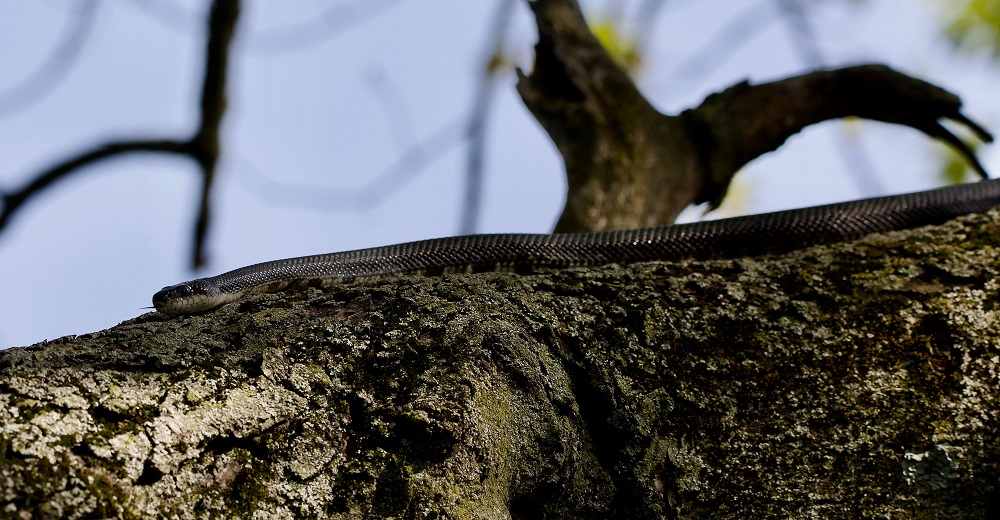
Snake Road bisects LaRue swamp and the limestone bluffs at LaRue-Pine Hill Research Natural Area. Photo by Mark Vukovich.



Snake Road bisects LaRue swamp and the limestone bluffs at LaRue-Pine Hill Research Natural Area. Photo by Mark Vukovich.
Located on the Shawnee National Forest within LaRue-Pine Hill Research Natural Area is a one-of-a-kind place that locals call Snake Road. Snake Road is a 2.5-mile-long gravel road that is closed to vehicles and open to foot traffic in observance of the biannual reptile and amphibian movement to and from the limestone cliffs and LaRue Swamp. Snake Road is great for viewing snakes in their natural habitat and is also a great place to view wildlife and local flora.
Twice a year, the LaRue-Pine Hills reptiles and amphibians experience seasonal movements; in the spring they leave their winter shelter and head to the swamps, and in the fall, they return to the limestone bluffs to stay over winter. Snakes may move a few miles compared to other migratory animals, such as some species of birds that annually travel thousands of miles between their wintering and breeding grounds. Snake Road bisects LaRue swamp and the limestone bluffs so snakes must cross the road, making it an excellent location to view them.

U.S. Forest Service (USFS) Wildlife biologist Mark Vukovich said the road was first closed to vehicle traffic in 1972 for three weeks each spring and fall to protect snakes during this migration. In the mid-1990s, the USFS, through guidance from a Southern Illinois University Master’s thesis by Illinois Department of Natural Resources Herpetologist Scott Ballard, began extending the road closure because Ballard’s research demonstrated it is longer than three weeks each spring and fall. The road is now open only to foot traffic between March 15 and May 15 and between September 1 to October 30. Vukovich may alter the closure dates at Snake Road because of weather patterns.
“Snake road is among the few places in the United States where you might be able to see 22 species of snakes in such a small geographic area,” Vukovich noted. “Commonly observed species are garter snakes, rough greensnakes, ring-necked snakes, DeKay’s brownsnakes and plain-bellied watersnakes.”

Northern cottonmouths, also known as water moccasins, are the most observed snake species on the road. One of the four venomous snake species native to Illinois, cottonmouths are semiaquatic snakes spending time both in water and on land. They can reach up to 5 feet long and have a thick body and flat, triangular-shaped head. Their color varies in shades of brown and black with vertical banding on the body. A dark line extends through the eye. Young cottonmouths are lighter in color with a yellowish-tipped tail, which they use to lure in prey, including frogs and lizards. As they reach adulthood the tail turns black. The name cottonmouth comes from the cotton-white color of their mouth that they flash open in defense.

It is hard to accurately estimate snake populations, but the twice-yearly closure of the road has benefited snakes and many other animals. Vukovich mentioned that a group of volunteers survey snakes on the road for the Master Naturalist Program. The University of Illinois Urbana-Champaign and USFS are partnering to organize the Master Natural Program. It is the third season of a budding volunteer program at Snake Road and Vukovich is hopeful that the program will continue and grow.
LaRue-Pine Hills-Otter Pond is a Federal Research Natural Area, so designated in 1991 as the 250th Research Natural Area in the nation. To protect the area and visitors, no handling of animals, or collecting of any plants or animals, is allowed. Snakes are protected under state law.
Illinois has four species of venomous snakes: copperheads, timber rattlesnakes, eastern massasaugas and cottonmouths. Many snake species here are harmless but it is best to treat every snake as if it could be venomous. Keep a safe distance from all snakes and observe from a distance. It is also recommended to stick to the paved road as snakes are excellent at blending into their environment and could be stepped on, possibly causing harm to you or the snake.
There are a few other rules that you should follow.
The number one priority of Snake Road is safety. When visiting, make sure you bring plenty of water, your camera and maybe a snack. Address: 475E, Wolf Lake, IL, 62998.
For more information visit the USDA page.
Willow Simmons works as a veterinarian technician and in her free time she practices wildlife photography. Her photography primarily focuses on southern Illinois wildlife where she is based.
Submit a question for the author
Question: Interesting article! I am somewhat handicapped so walking the trail would be difficult. Are cars allowed during the non migration periods?
Thank you!